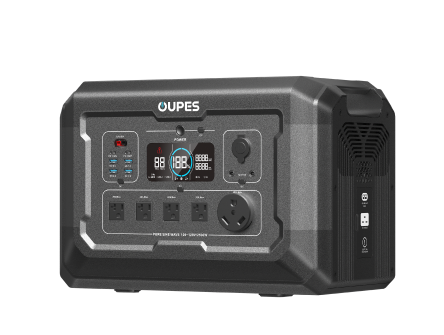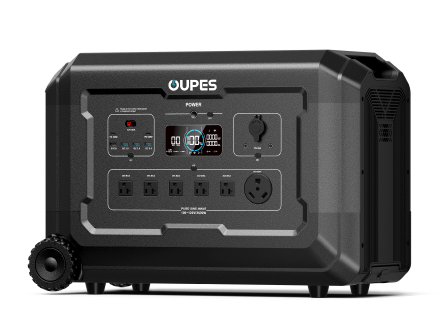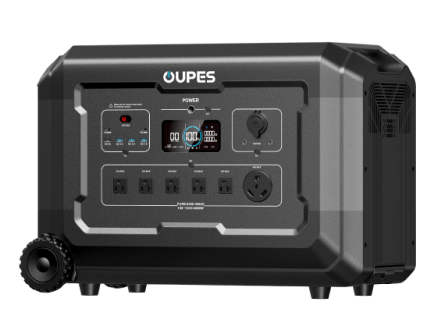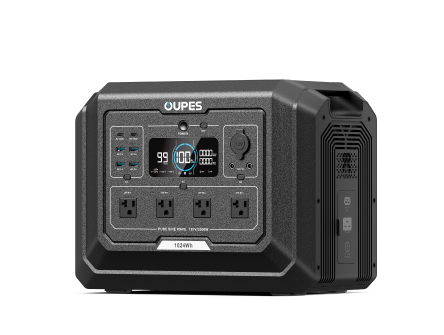
TL;DR / Key Takeaways
- Most routine outages are resolved within hours; severe weather or infrastructure damage can push restoration to days, and catastrophic events can last weeks.
- Duration depends on cause (weather, maintenance, grid stress), access and safety, crew availability, and where you live (urban vs. rural, overhead vs. underground lines).
- Plan in tiers: be ready for 4 hours, then 24 hours, then 72 hours, and ideally 7 days+.
- Portable and expandable backup power like the OUPES Mega and Exodus series can keep essentials running—from phones and medical devices to refrigerators and space heaters (within rating limits).
- Use the simple sizing method and tables below to estimate runtime and choose the right OUPES solution.
What Actually Determines Outage Length?
Outage timelines vary widely. Two homes on the same street can see different restoration times, depending on local damage, feeder topology, and safety requirements. Here are the biggest drivers.
1) The Cause
- Routine equipment trips & small faults: Often restored quickly once crews arrive.
- Planned maintenance: Typically scheduled and shorter, with advance notice.
- Severe weather: High winds, ice, floods, and wildfire risk can delay repairs and require system-wide de-energizing.
- Grid stress: Heat waves may trigger rolling outages to protect the system.
2) Safety & Logistics
- Make-safe protocols: Lines must be de-energized and grounded before repairs.
- Access & terrain: Crews may need to clear debris, reach remote rights-of-way, or wait for floodwaters to recede.
- Prioritization: Critical facilities (hospitals, water plants) typically come first, then large feeders, then smaller laterals.
3) Where You Live
- Urban vs. rural: Denser areas often see faster restoration; long rural feeders can take longer.
- Overhead vs. underground: Overhead is faster to repair but more exposed; underground is protected but can be complex to locate and fix.
Typical Timelines by Scenario
Every event is unique, but these scenario-based expectations help you plan. Treat them as planning guides rather than guarantees.
| Scenario | What Usually Happens | What to Plan For |
|---|---|---|
| Local equipment trip / blown fuse | Crews isolate and restore once on site | Up to 4 hours |
| Planned maintenance | Announced in advance; limited duration | 1–4 hours |
| Thunderstorm / wind event | Scattered damage; phased restoration | 4–24 hours |
| Ice / snow & downed lines | Access issues; complex repairs | 1–3 days |
| Heat wave rolling outages | Timed blocks to reduce load | 1–4 hours per block |
| Public Safety Power Shutoff (wildfire risk) | Lines de-energized until conditions improve | 24 hours to several days |
| Hurricane / flooding | Widespread damage; sequential feeder restoration | 3 days to weeks |
| Remote / rural feeder damage | Fewer crews; long distances | 1–5 days |
How to Prepare—By Duration Tier
Up to 4 hours
- Keep phones and battery banks topped off.
- Avoid opening refrigerators/freezers; thermal mass buys time.
- Power essentials with a compact station like OUPES Exodus 1200 (for lights, routers, laptops, CPAP—check ratings).
4–24 hours
- Run refrigerators intermittently to maintain safe temps.
- Charge phones, radios, and medical devices; plan for evening lighting.
- Consider mid-capacity stations (e.g., OUPES Mega 2 or Exodus 1200) and add solar to recharge during daylight.
1–3 days
- Prioritize refrigeration, communications, and a room for heating/cooling (space heater or portable A/C within device limits).
- Look to higher-capacity units (OUPES Mega 3) and solar input for daily replenishment.
- Prepare for safe food handling and water needs.
3+ days
- Home-backup scale power (OUPES Mega 5 with expandable batteries) covers most essentials and critical tools.
- Combine solar panels for daytime replenishment; schedule high-draw tasks when charging is abundant.
- If noise rules and safety allow, pair with an OUPES E1600 Gas Generator to recharge at night or during cloudy stretches.
Right-Sizing Backup Power (Simple Method)
Use this four-step approach to estimate daily energy needs, then choose an OUPES setup that meets (or exceeds) that number.
The 4-Step Method
- List essentials (fridge, router, phone/laptop charging, a few lights, medical devices, a fan or space heater).
- Note wattage (device label or manual). Use average draw, not peak.
- Estimate hours/day each will run during an outage.
- Multiply Watts × Hours = daily Watt-hours (Wh). Add ~15–20% buffer for inverter/charging losses.
| Device | Avg Watts | Hours/Day | Daily Wh |
|---|---|---|---|
| Refrigerator (modern, cycling) | 150 | 10 | 1,500 |
| Wi-Fi router + modem | 20 | 24 | 480 |
| LED lighting (4 bulbs) | 36 | 6 | 216 |
| Laptop + phone charging | 80 | 3 | 240 |
| CPAP (as applicable) | 50 | 8 | 400 |
| Fan / space heater (intermittent) | 200 | 4 | 800 |
| Estimated daily total | 3,636 Wh |
With a 15–20% buffer, target roughly 4.2–4.4 kWh/day. A standalone OUPES Mega 3 (3,072Wh) can cover a leaner plan or a single day with conservation; adding solar extends runtime. For multi-day comfort and more devices, the OUPES Mega 5 with expandable batteries (up to 45.36 kWh) is built for whole-home scenarios.
OUPES Solutions at a Glance
OUPES designs quiet, indoor-safe power stations for outage resilience—from grab-and-go portability to expandable whole-home backup.
| Product | Capacity (Wh) | Rated / Surge (W) | Expandable | Charging Highlights | Notable Features | Best For |
|---|---|---|---|---|---|---|
| OUPES Mega 5 | Base + up to 45,360 | 4,000 / 7,000 | Yes (B-series batteries) | AC + Solar up to 3,900W; ~1.3h full in AC+Solar | Seamless UPS Backup (2,100W max), up to 16 ports | Whole-home essentials, long outages |
| OUPES Mega 3 | 3,072 (expandable to ~15,360) | 3,600 / 7,000 | Yes (B2 units) | AC 1,800W + Solar 2,100W (3,900W combined) | 16 output ports, fast recharge | Family essentials, 1–3 day outages |
| OUPES Mega 2 | 2,048 | 2,500 / — | — | Fast AC + Solar | Compact, versatile | Apartments, short outages, RV trips |
| OUPES Exodus 1200 | — | 1,200 / 1,500 (boost) | — | 600W AC; up to 240W solar | Dual 140W USB-C, EPS (<20ms) for sensitive loads | Personal essentials, devices, CPAP |
| OUPES Titan 5 | 5,000 | 4,000 / — | With B5 extra batteries | High-efficiency LiFePO₄; secure BMS | Low noise (~60dB @1m), robust inverter | Worksites, home backup, RV |
| OUPES B2 Extra Battery | — | — | Standalone output capability | Up to 2,100W solar input | Multiple ports (Anderson, DC, USB-C PD, etc.) | Modular expansion & solar-only charging |
| OUPES B5 Extra Battery | — | — | For Mega 5 / Titan 5 | EV-grade LiFePO₄ (≈3,500 cycles) | 10-year lifespan design | Whole-home energy stacking |
| OUPES 240W Solar Panel | — | — | N/A | High-efficiency; MC4 universal connector | ETFE, multi-layer protection | Daylight replenishment for longer outages |

How Long Will My Essentials Run?
Runtime depends on device draw, duty cycle, ambient temperature, and how efficiently you use power. As rough planning guides:
- Refrigerator on OUPES Mega 3 (3,072Wh): With a ~150W average draw, expect roughly 16–18 hours of runtime before recharging (conservative allowance for inverter losses).
- Networking + phones + LED lights on Exodus 1200: A ~300–350W combined draw can be supported for an evening and into the night with smart use.
- Whole-home essentials with Mega 5 + extra batteries: Scale capacity up to 45.36 kWh to bridge multi-day outages, especially when paired with solar to recharge daily.
Tip: Cycle high-draw appliances (fridge, space heater) and shift tasks to midday while solar is charging to stretch runtime.
FAQ
How long can a power outage last after a major storm?
Anywhere from a day to multiple days, depending on damage extent, crew access, and safety checks. In rare catastrophic cases, restoration can take weeks. Plan for 72 hours minimum if your area is storm-prone.
How do I know what size OUPES system I need?
Add up your essential daily Watt-hours (see table above), add 15–20% buffer, then choose a station (and extra batteries) that covers at least that much. If you want to run high-draw tools or HVAC, pay close attention to inverter rated and surge watts.
Is it safe to power medical devices?
Yes—within the device’s power requirements. For sensitive loads, look for fast backup switchover. OUPES Mega 5 supports Seamless UPS Backup (2,100W max). Always confirm your device’s power needs and consult your physician for medical-critical scenarios.
Can solar panels keep me going indefinitely?
With good sun, OUPES 240W panels can replenish a meaningful portion of daily use. Combine multiple panels and schedule high-draw tasks during peak sun for best results. Weather, shading, and panel orientation affect harvest.
Apartment dweller—what’s realistic?
Focus on silent, indoor-safe solutions like the Exodus 1200 or Mega 2 for lights, devices, router, and a small fan. Store water, shelf-stable food, and keep a compact lighting kit ready.
What about nighttime or cloudy weeks?
For extended events, pair your station with extra batteries and consider the OUPES E1600 Gas Generator to recharge when solar is limited. Observe all safety guidelines for generator use.
Printable Outage Readiness Checklist
Essentials
- Water (1 gallon per person per day, minimum 3 days)
- Shelf-stable food & manual can opener
- First-aid kit & necessary medications
- Flashlights & headlamps (with spare batteries)
- Power station: charged OUPES unit + cables
- Solar panel(s) and safe outdoor setup plan
- Portable radio for updates
- Paper copies of important contacts
Home Setup
- Decide which circuits/devices you’ll power (prioritize fridge, comms, lights)
- Test-run your OUPES system quarterly
- Stage extension cords & label plugs for quick changeover
- Store fuel safely if using a generator to recharge
About This Guide
This scenario-based guide is produced by OUPES with a focus on practical, user-first planning. We design and test portable, expandable energy systems for homes, RVs, and field work. Always follow local safety guidance and device manuals when operating backup power equipment.




























